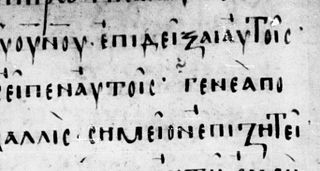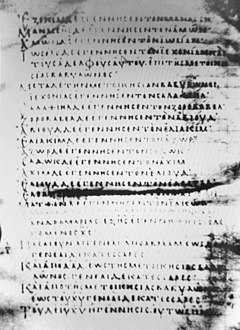Minuscule 672, ε 156, is a Greek minuscule manuscript of the New Testament, on parchment. Palaeographically it has been assigned to the 11th century. The manuscript is a very lacunose. Scrivener labelled it by 618e.
Minuscule 705, ε360, is a Greek minuscule manuscript of the New Testament, on parchment. Palaeographically it has been assigned to the 13th century. The manuscript has complex contents. Scrivener labelled it by 887e.
Minuscule 710, ε348, is a Greek minuscule manuscript of the New Testament, on parchment. Palaeographically it has been assigned to the 13th century. The manuscript is lacunose. Scrivener labelled it as 81e.
Minuscule 762, ε477, is a Greek minuscule manuscript of the New Testament written on parchment. Palaeographically it has been assigned to the 14th century. The manuscript has complex contents. Scrivener labelled it as 852e.
Minuscule 774, ε194, is a Greek minuscule manuscript of the New Testament written on parchment. Palaeographically it has been assigned to the 11th century. The manuscript has complex contents. Scrivener labelled it as 869e. It has marginalia and liturgical books.
Minuscule 777, ε469, is a Greek minuscule manuscript of the New Testament written on parchment. Palaeographically it has been assigned to the 12th century. The manuscript has complex contents.
Minuscule 779, ε472, is a Greek minuscule manuscript of the New Testament written on parchment. Palaeographically it has been assigned to the 12th century. The manuscript has complex contents.
Minuscule 783, ε462, is a Greek minuscule manuscript of the New Testament written on parchment. Palaeographically it has been assigned to the 14th century. The manuscript has complex contents.
Minuscule 785, ε197, is a Greek minuscule manuscript of the New Testament written on parchment. Palaeographically it has been assigned to the 11th century. The manuscript has complex contents.
Minuscule 790, ε613, is a Greek minuscule manuscript of the New Testament written on paper. Palaeographically it has been assigned to the 14th century. The manuscript has no complex contents. It contains liturgical books.
Minuscule 796, δ161, is a Greek minuscule manuscript of the New Testament written on parchment. Palaeographically it has been assigned to the 11th century. The manuscript has no complex contents. Formerly it was designated by 796e, 263a, and 312p.
Minuscule 799, ε196, is a Greek minuscule manuscript of the New Testament written on parchment. Palaeographically it has been assigned to the 11th century. The manuscript has complex contents.
Minuscule 801, δ553, is a Greek minuscule manuscript of the New Testament written on paper. Palaeographically it has been assigned to the 15th century. The manuscript has complex contents.
Minuscule 811, ε4005, is a Greek minuscule manuscript of the New Testament written on parchment. Palaeographically it has been assigned to the 13th century.
Minuscule 831, ε117, is an 11th-century Greek minuscule manuscript of the New Testament on parchment. The manuscript is lacunose.
Minuscule 1076, ε1140, is a 10th-century Greek minuscule manuscript of the New Testament on parchment. The manuscript does not contain gaps.
Minuscule 1073, δ97, is a 10th or 11th-century Greek minuscule manuscript of the New Testament on parchment. The manuscript has survived in complete condition. It contains additional non-biblical matter. There is no marginalia.
Minuscule 1074, ε2007, is an 11th-century Greek minuscule manuscript of the New Testament on parchment. The manuscript has not survived in complete condition. It has some marginalia.
Minuscule 1080 (in the Gregory-Aland numbering), A312 (von Soden), is a 9th-century Greek minuscule manuscript of the New Testament on parchment. The manuscript has not survived in complete condition.
Minuscule 873, ε103, is an 11th-century Greek minuscule manuscript of the New Testament on parchment. The manuscript has survived in complete condition.







